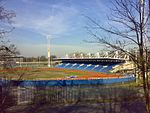Penge West railway station

Penge West railway station is located in Penge, a district of the London Borough of Bromley in south London. The station is operated by London Overground, with Overground and Southern trains serving the station. Thameslink and some Southern services pass through the station. It is 7 miles 15 chains (7.19 miles, 11.57 km) down the line from London Bridge, in Travelcard Zone 4. Penge East station is a short walk away and has services to London Victoria, Bromley South and Orpington. Crystal Palace station is also within walking distance and has more frequent trains to London Bridge.Penge West station forms part of the new southbound route of the London Overground East London line that opened on 23 May 2010. Penge West station provides convenient access to The Dinosaur Park via the south gate of the Crystal Palace Park.
Excerpt from the Wikipedia article Penge West railway station (License: CC BY-SA 3.0, Authors, Images).Penge West railway station
Thicket Road, London Crystal Palace (London Borough of Bromley)
Geographical coordinates (GPS) Address Nearby Places Show on map
Geographical coordinates (GPS)
| Latitude | Longitude |
|---|---|
| N 51.4174 ° | E -0.0648 ° |
Address
Crystal Palace Park
Thicket Road
SE20 8DP London, Crystal Palace (London Borough of Bromley)
England, United Kingdom
Open on Google Maps









